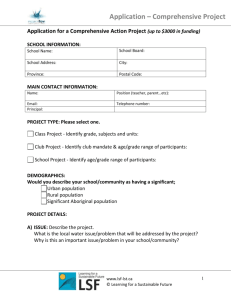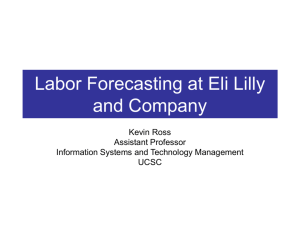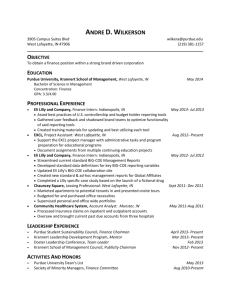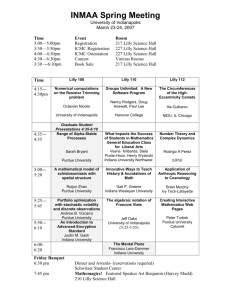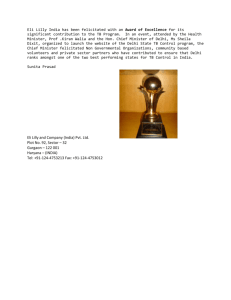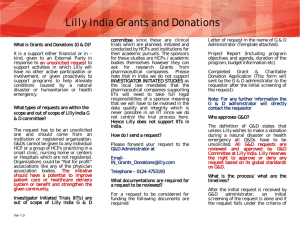Remarks at the Economic Club of Indiana The Path We Have
advertisement
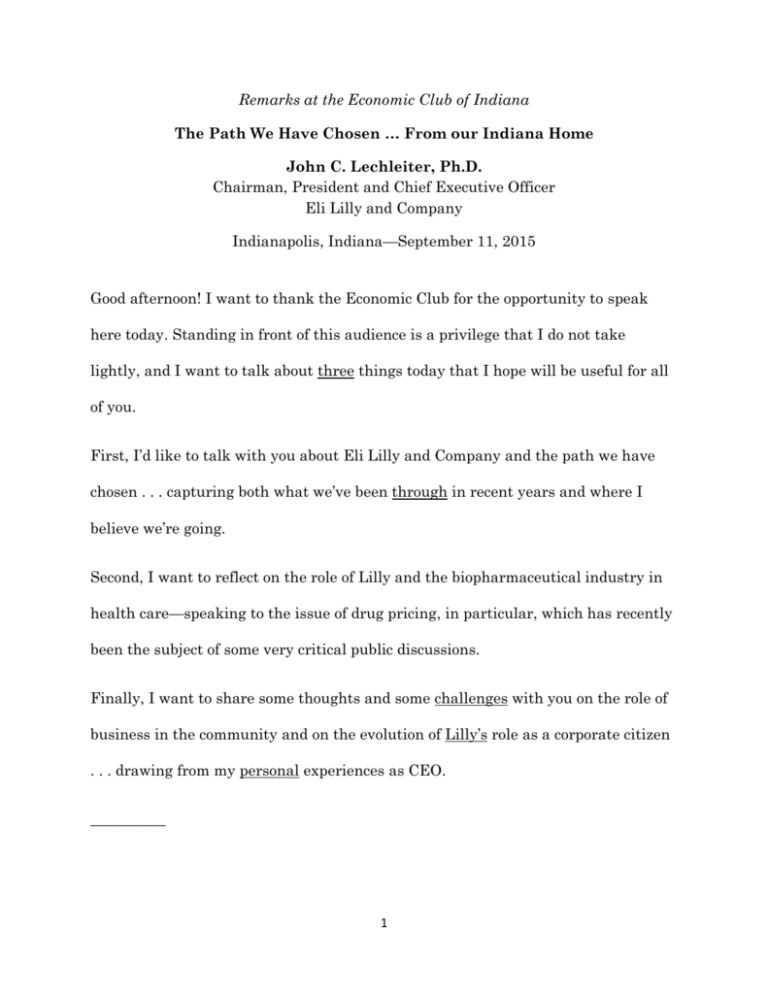
Remarks at the Economic Club of Indiana The Path We Have Chosen … From our Indiana Home John C. Lechleiter, Ph.D. Chairman, President and Chief Executive Officer Eli Lilly and Company Indianapolis, Indiana—September 11, 2015 Good afternoon! I want to thank the Economic Club for the opportunity to speak here today. Standing in front of this audience is a privilege that I do not take lightly, and I want to talk about three things today that I hope will be useful for all of you. First, I’d like to talk with you about Eli Lilly and Company and the path we have chosen . . . capturing both what we’ve been through in recent years and where I believe we’re going. Second, I want to reflect on the role of Lilly and the biopharmaceutical industry in health care—speaking to the issue of drug pricing, in particular, which has recently been the subject of some very critical public discussions. Finally, I want to share some thoughts and some challenges with you on the role of business in the community and on the evolution of Lilly’s role as a corporate citizen . . . drawing from my personal experiences as CEO. __________ 1 As some of you may remember, this is my second address to the Economic Club. My first time was almost exactly seven years ago, on September 24, 2008. I had become Lilly’s CEO just a few months earlier . . . and you were kind enough to allow me to share an overview of our plans. I remember that occasion pretty well! On the same day, just a few hundred yards away, the roof of the RCA Dome was being “deflated” in front of crowds of people and news cameras. I was a little concerned that no one would come to listen to my speech . . . since I could not promise to bring the roof down over here! Actually, that giant hiss of air . . . escaping from a bubble . . . was a metaphor for what was going on in the global economy at the same time. Nine days earlier, Lehman Brothers had filed for bankruptcy. Five days later, the New York Stock Exchange experienced its worst session in more than 20 years, as 1.2 trillion dollars of market capitalization vanished . . . in a single day! Stock markets around the world would continue to plummet for weeks . . . as central banks and governments hatched bailout and stimulus packages . . . trying to stay ahead of credit defaults and enormous investor anxiety. It was the scariest time for the world economy since the start of the Great Depression. It also was among the scariest times in the history of Eli Lilly and Company. And the challenges Lilly faced had a life of their own . . . quite apart from the financial crisis. 2 We were about to drive over the largest “patent cliff” in the company’s history . . . and one of the worst ever faced in the pharmaceutical industry. As we looked just ahead to the period starting in 2011, Lilly faced the prospect of losing patents on four of our largest products. In 2009, they accounted for nearly nine billion dollars in sales . . . fully 40 percent of our revenues and an even higher percentage of our profits. We had to give this road-trip-from-hell a name . . . so we called the period between 2011 and 2014 “the Years YZ.” Some of you may remember that we called the period following Lilly’s loss of the Prozac patent in 2001: “Year X.” And we knew that what awaited us in 2011 would be even worse—requiring whatever letters remained in the alphabet! The loss of patents accounting for 40 percent of revenues was bad enough. But on the other side of the equation, there were not enough assets in our late-stage research pipeline, as it stood in early 2008, to fill the gap . . . certainly not in time to make up for the revenue losses. And that was before most of that late-stage pipeline went on to fail unexpectedly in clinical testing . . . right into 2010, as it turned out. So, we had our work cut out for us. It was going to be like building a bridge . . . while crossing it . . . literally. In our approach to this challenge, the management team followed one guiding principle above all. We would take a long-term view . . . and act accordingly. There would be no quick fixes. 3 And so our response to “the Years YZ” had three major components. First, we had to start rebuilding the bridge . . . our pipeline . . . in a way that would last. That effort began in earnest about two weeks after I spoke here in 2008, when we announced plans to acquire ImClone—a biotechnology firm with one oncology product, Erbitux, already on the market . . . and a promising, late-stage anti-cancer pipeline. At a price tag of six-and-a-half billion dollars, it was the largest acquisition in Lilly’s history. We certainly got no points for timing! In the midst of the financial crisis, commercial credit markets essentially shut down the very week we announced the deal. But fortunately, we were able to use our strong balance sheet to get the deal done. We made other, smaller acquisitions of specific molecules and technologies along the way. But most significantly, we didn’t shy away from making the necessary investments in our internal R&D . . . and we actually increased R&D spending in each year leading up to 2014. During these years, Lilly’s R&D investments . . . as a percentage of sales . . . have grown to some of the highest levels in an industry already known for massive research spending. You can see here that Lilly spent about five billion dollars per year on R&D since 2010. That’s the equivalent of paying for six Lucas Oil Stadiums . . . per year! To make these sorts of investments in R&D and to partially offset the huge revenue losses, we needed to run the entire company—including our labs and our clinical4 research efforts themselves—ever more efficiently . . . and to scale back the size of our workforce globally. Without question, this second component of Lilly’s response to “the Years YZ” was the most painful. Some of the early decisions changed our decades-old footprint in Indiana. In 2008, we sold our Greenfield laboratories to Covance, and a year later, we sold our huge manufacturing facility in West Lafayette to Evonik, a German company. Fortunately, employment was maintained in both locations. In late 2009, we also made a major change in Lilly’s internal structure—creating separate “business units” that would take charge of our diabetes, oncology, and biomedicines product portfolios . . . and another that would focus on our entire portfolio in the emerging-market countries. Elanco, our animal-health business, already had been operating essentially as a separate business unit from its home base in Greenfield. The third and final piece of our YZ strategy was to drive growth in the products and geographies where opportunity lay during this difficult period. This led to a particular focus on Elanco . . . as well as on the “emerging markets” . . . China, in particular . . . and on Japan, where products historically came on the market later and therefore did not face the same early patent expirations as in the rest of the world. And each of them came through in a big way! These growth drivers were key stabilizers of that bridge across “Years YZ”! 5 __________ My reflections beg the obvious questions: Has Lilly completed that bridge we were building and trying to cross? And will the bridge hold? To answer those questions, let me refer to three obvious benchmarks: the condition of our business today, the current state of our research pipeline, and the trajectory of our stock price. Looking at our business, I’ll start with animal health. Following our acquisition of Novartis’s animal-health business at the beginning of this year, Elanco today is a top three animal-health player globally . . . anticipating three-point-five billion dollars in revenue this year and a very bright future. Lilly Diabetes—which consummated a global partnership with Germany’s Boehringer Ingelheim in early 2011—has launched no fewer than eight products since that year and remains a strong engine for growth in a therapeutic category that Lilly quite literally invented here in Indianapolis nearly a century ago . . . when we were first to manufacture insulin on a commercial scale. Meanwhile, our oncology business also is in what seems like continuous launch mode . . . and could have as many as five or six products on the market by the beginning of the next decade, including our existing portfolio. And Lilly Bio-Medicines . . . our largest business and the one that bore the brunt of our patent expirations . . . has transformed itself and today is closing in on new 6 treatments for patients who suffer from Alzheimer’s disease, cardiovascular disease, psoriasis, rheumatoid arthritis, and several types of pain conditions. I likewise feel very optimistic about Lilly’s future when I look at our pipeline. The chart I’m showing you here is a one-page snapshot of Lilly’s portfolio of products in development . . . going left to right from the first stage of clinical testing in people . . . to final regulatory review before approval and launch. Inevitably, it slopes downward to smaller numbers on the right because many of these molecules will fail along the way. That’s the nature of our business, I’m afraid. I could go through this chart, story-by-story . . . since in fact every molecule has a story behind it . . . typically involving hundreds of Lilly people . . . many of them your neighbors here in Indiana. But let me simply focus on the headlines: What you see here is the strongest mid- to late-stage pipeline in Lilly’s history . . . by a wide margin. The strength is qualitative as well as quantitative. There are a large number of opportunities in this mix . . . and I believe they are also high-value opportunities—targeting diseases such as Alzheimer’s that burden patients and health-care systems around the world. Some of these molecules will in fact fail . . . as so many others have done in the past. But the depth of this pipeline is such that we should never find ourselves with fewer than seven to nine molecules in Phase 3—the final phase of testing. 7 Sustaining this kind of pipeline will require robust, early-stage investments and myriad partnerships. So you will continue to find Lilly being highly active in business development efforts worldwide . . . involving academic partners, small biotechnology companies, and other large pharmaceutical companies alike. Turning to the final benchmark: say what you will about the cruelties of markets . . . at the end of the day, the stock price is the telltale measure of external confidence in a business. As Lilly approached its “YZ” crisis at the end of the last decade, our stock price reflected two things pretty clearly: the size of the challenges before us . . . and the skepticism of many investors that Lilly’s strategy would enable us to overcome our pipeline problems. But we’ve delivered on our strategy and put Lilly’s R&D drought behind us. The market has responded in kind. Our stock price is up about 194 percent since our low in early 2009. While some investors might have assumed, six or seven years ago, that we would disappear in a takeover . . . investors today rank Lilly’s growth prospects near the top of the entire bio-pharmaceutical industry. None of this would have been possible without the dedication and hard work of the thousands of Lilly employees around the world. They are just the best! I was reminded of the correspondingly small part that I played when I recently met . . . at a local civic event . . . an elderly gentleman who had been following Lilly’s fortunes. Commenting on my performance as CEO over this period, he said succinctly: “You certainly surprised many of us!” 8 __________ So . . . yes, we built the bridge while we were crossing it . . . and I believe that the bridge is strong enough to hold. And strong it must be, because today . . . we do not want for fresh challenges: We face a new breed of competitors: larger, pure-play biotech companies optimized to bring treatments in designated therapeutic areas to market very rapidly . . . as well as another breed whose business model is not to discover and develop new medicines as much as to acquire new medicines . . . by swallowing up other companies that already did the R&D. There’s also a new category of competitor coming from outside our industry entirely. Businesses such as Apple and Google are developing devices and digital applications that aim to fundamentally change the way patients with diseases such as diabetes are diagnosed and treated. Meanwhile, a number of important markets around the world . . . China and the U.S. are at the top of the list . . . are going through enormous changes where pricing, intellectual property, and market-access issues are concerned. Drug pricing, in particular, has grabbed the headlines recently . . . so I want to spend a bit of time on this topic. As I speak about pricing, I want to share three basic qualifiers—things that rarely, if ever, get mentioned in media accounts of exorbitant prices for new medicines: 9 First: the prices for medicines you see quoted in the media don’t often get paid by anyone. As in most other businesses, our industry must negotiate with our buyers . . . typically large insurance companies or pharmaceutical benefit managers like CVS Caremark—the one that Lilly uses to manage its own employees’ prescription-drug benefits. They drive hard bargains . . . so that the actual prices paid reflect significant discounts. And, as the chart shows, health plans have many other levers to reduce spending on medicines. Second: what gives those buyers leverage—not unlike other businesses—is competition . . . and yes there’s plenty of it in the pharmaceutical industry. Lilly aims for first-in-class breakthroughs . . . but it’s ironic that our industry as a whole has been criticized for bringing products to market that are similar to others: socalled “me-too drugs.” Well, that’s exactly what begets price competition . . . in addition to offering patients a broader range of potentially effective treatments. As the chart indicates, the median time between the appearance of the first new product in a class . . . and the launch of its first competitor . . . has shrunk dramatically in recent decades, to a little over a year. And finally: never forget that we are one of the few industries that give birth to its own most potent price competitors. I’m talking about generic medicines. Without the initial breakthrough medicines, health-care systems would not have the benefit . . . a few years later . . . of less expensive generic versions. And it’s worth noting that almost nine out of 10 prescriptions written today in the U.S. are for generics. 10 The three things I’ve just shared are important to keep in mind . . . but I’d still be the first to acknowledge that on the face of it, many new, patented medicines are expensive. Their prices are high because they cost a lot to create in the first place . . . and because they deliver a great deal of value. That value takes different forms depending on the nature of the innovation and the disease being targeted. It could be extra months and years of life. It could be fewer side effects as compared with older treatments. It could be an alternative to expensive and debilitating surgery. It could be the avoidance of disease (think of the cholesterol-lowering medicines or medicines that help prevent osteoporosis). Or it could be an outright cure—eliminating what otherwise might be years of costly treatment and disability. All of these things provide tremendous value to patients, and they also tend to save money for the health-care system as a whole. Unfortunately, many health insurance plans in the U.S., by their design, continue to mask much of the value delivered by medicines . . . by forcing patients to pay a disproportionate share of their prescription-drug costs out-of-pocket . . . compared with other forms of care. Notwithstanding co-pay assistance . . . often provided by pharmaceutical companies . . . patients pay an average of 19 percent of the costs for medicines themselves . . . and often much more for cancer treatments and other specialty products . . . compared with about five percent of the costs for hospital charges. 11 The resulting “shocks at the pharmacy counter” create the impression that medicines are the drivers of rising health-care costs . . . when in fact they’ve been among the few brakes on total costs over time. The bottom line is that medicines today remain a small portion of total health care spending. What’s really costly, after all, is disease . . . particularly chronic disease . . . which accounts for 75 percent of what we spend on health care in this country. Modern medicines are not the problem. They are the solution! I share this with you to provide some context . . . the next time our company or another one stands accused of charging too much. But I also recognize that it remains our industry’s job . . . as it should . . . to deliver truly valuable new treatments for patients fighting diseases—like diabetes, like cancer, and like Alzheimer’s—that still cry out for more effective care. Lilly aims to continue doing that . . . from right here in Indiana . . . which is where I’d like to turn now. __________ There’s an old saying around town that I’m sure many of you have heard: “When Lilly catches a cold, Indiana gets the flu.” It’s meant to convey the spillover effects of our down times on the regional economy—as Lilly and its employees tighten their belts. Notwithstanding our recent experience, I’ve thought for a long time that the saying exaggerates reality. In fact, I believe that it would be better for all concerned if we turned the old saying on its head. “When Indiana catches a cold, then Lilly risks the flu” . . . and not just 12 Lilly, of course. I ask each of you to fill in the name of your business. And I challenge you to think of this relationship not only in economic terms . . . but much more broadly: Think about the quality of public education that kids can receive in central Indiana . . . starting with early childhood education before kindergarten . . . and ask yourself if that matters to the quality of tomorrow’s workforce. Think about the quality of life in our towns and cities . . . cultural life, outdoor life, and spiritual life along with the strength of our safety nets. Think about the condition of our roads and infrastructure. Ask yourself if those things matter in the decisions that you and other business leaders make about where to locate or whether to expand your operations. And think about the image of our state in the nation and in the world . . . our reputation as a welcoming and harmonious place . . . and ask yourself if that matters in your relationships with recruits and customers alike. We’ve done these sorts of mental exercises at Lilly, and in almost every instance the answer has been the same: These things do matter . . . big time. To put it as simply as possible: the health of our communities is a major factor in determining the health of our businesses. And . . . much as I described the guiding principle of our company strategy . . . we believe that it’s essential to take the long-term view to help achieve community progress. 13 At Lilly, that common-sense realization led us to do a number of things in recent years to support local development—from a strong role in the Super Bowl bid . . . to partnership in the CityWay project and the new YMCA . . . to an active role in helping to launch the new Indiana Biosciences Research Institute. It led us to help broker a legislative compromise during the controversy earlier this year over the Religious Freedom Restoration Act . . . extending current protections for LGBT citizens for the first time in state law . . . and helping to restore Indiana’s reputation, which I believe is a well-deserved reputation, as one of the most welcoming places in the world. And it also led us to put up our own financial resources as matching funds . . . and to take more of a hands-on approach than ever before . . . to make sure once and for all that disadvantaged children in Indianapolis have access to good-quality preKindergarten programs. I’m very pleased to say that 80 percent of the 10 million dollars pledged by Lilly and the business community towards pre-K have been raised . . . and the program is off and running in the new school year! Thanks to the commitment of Mayor Ballard, along with City-County Council leaders Maggie Lewis and John Barth, it was a bipartisan effort of the kind we’re led to believe is not possible anymore. Our intention in recent years to positively influence community development . . . and to help address other challenges outside our walls . . . has led to a sharpened focus of our corporate foundation. Globally, we’ve focused on health issues such as 14 drug-resistant tuberculosis and diabetes, as well as funding Elanco’s hunger relief work. Closer to home, here in Indy, we’ve directed a substantial portion of our foundation’s resources to improving educational outcomes for disadvantaged children . . . by supporting education reform—including, of course, the new pre-K program. Finally, I’m happy to report that Lilly is on the verge of putting in place a new agreement with our key community partner . . . United Way of Central Indiana . . . that will cement our longstanding relationship, expand the scope of activities between us, and create even greater community impact. Under the leadership of Ann Murtlow, our United Way has continued its transformation . . . begun by Ellen Annala . . . from a funder of community agencies into a true impact organization—developing strategies and focusing resources like never before on education, income, and health . . . along with basic needs. United Way today represents our best hope for positive change in our community, and as the fall campaign gets underway, I would ask everyone here to lend your full support to this effort. All of this is to say: As a corporate citizen, Lilly will not shirk from its duty to ensure that our Indianapolis and Indiana communities remain strong. In fact, we are stepping up our engagement. Our recent actions demonstrate that our involvement, on occasion, will be forceful and direct. Particularly at this time in history, I happen to believe that this is 15 appropriate and warranted for any of our businesses. As Brian Gallagher . . . the CEO of United Way Worldwide . . . commented to me recently: business, by its very nature, is pragmatic. And business is often in a unique position to solve problems at scale. Given what’s at stake for our city and region, the involvement and engagement of business in the public commons has never been more important. Going forward, I urge even greater collaboration and cooperation between our business community, government, academia, and our strong not-for-profit sector . . . in order to keep our Indiana home a vital, viable, and forward-looking place . . . competitive with the best and compassionate to the core. __________ Ladies and Gentlemen: Thank you for this privilege of speaking to the Economic Club of Indiana for a second time. I can sum up what I hoped to leave with you in a few words: Lilly built itself that new bridge . . . while we crossed it. If we caught a cold along the way, we’re over it. And Indiana did not get the flu. Things are pretty healthy here. Yet our city and state can get better still . . . if businesses step up . . . as hands-on partners with each other and with the rest of the community. And let me say that Lilly’s new bridge was but one more feature on a long path. 16 The path we have chosen at Lilly remains, in many ways, the path marked out by Colonel Eli Lilly and his family . . . beginning almost a century-and-a-half ago. It’s a path to scientifically validated, breakthrough medicines for patients with difficult diseases. It’s a path clearly bounded by our values of integrity, excellence, and respect for people . . . which the family itself laid down. The path we have chosen at Lilly is bound up inextricably with Indiana, this place we are from . . . and have always called home. And I believe we have something special here in Indiana. I’m glad that Lilly can continue to be a part of it, stronger and ready for the future. I’m lucky that I have been able to be a part of it, alongside all of you. And I’m grateful for your interest in what I’ve said here today. Thank you! ### 17
